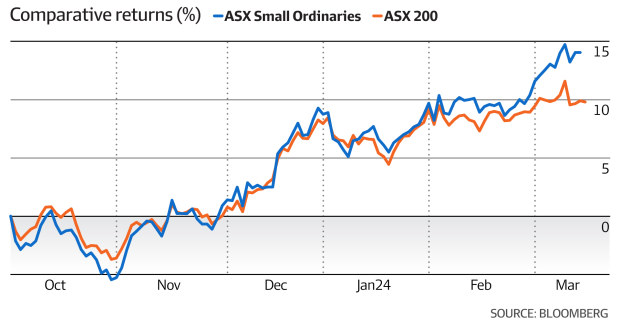The trend is more pronounced in the US, where 12 months of outsized gains from the so-called magnificent seven – Alphabet, Amazon, Apple, Meta, Microsoft, Nvidia, and Tesla – had kept investors from venturing to the smaller end of the market.
Richard Ivers and Mike Younger, who run the Prime Value Emerging Opportunities Fund, are among the few to have consistently outperformed its ASX small-cap benchmark in what they described as a hugely volatile market for small-cap managers.
“There’s been a period of interest rates going up and interest rates going down – you’ve had bull markets and bear markets, tech booms and tech wrecks – it’s really tested a lot of different investing styles,” Mr Younger said.
“Small-caps are a higher risk, so over the last 18 months they sold off as you saw people go towards larger caps and defensive stocks.”
Still tentative
Mr Younger – who previously led small-cap research at Goldman Sachs and Citi – said signs were emerging that the long-awaited revival in the segment was picking up steam.
“It does seem to be changing. Every other week, you’re reading about the invariable mean reversion of small caps,” Mr Ivers added.
“History suggests that you don’t tend to have much longer or larger periods of underperformance of small versus large than what we’ve had lately.”
Even so, Luke McMillan, head of investment research at Ophir Asset Management, cautioned that the outperformance of small caps was patchy in the ASX’s recent rally, by historical standards.
“At the start of every sustainable bull market going back to the 1960s, you typically see strong, broad outperformance month-on-month by small caps over large caps,” he said.
“Since developed markets began rebounding in October, we really haven’t seen that sustained outperformance – it’s been spotty here and there – but we’re seeing a little bit more evidence of it recently.”

Mr McMillan attributed the stop start performance to lingering concerns about the possibility of a recession in the US or Australia, as well uncertainty around the timing of rate cuts from major central banks.
“Market leadership in the US has largely been just sticking to the same script of supporting the magnificent seven and backing these mega cap tech stocks,” he said.
“But for this to be a durable bull market we will need this to broaden out. The key catalyst for that will be getting more confidence that inflation is going to return to target without any meaningful uptick in unemployment or fall off in economic growth.”
Jim Shore, a global small-cap specialist and senior client portfolio manager at American Century, said while it was true that investors were returning to smaller companies, they were still cautious.
“We’re having more and more conversations with our existing and prospective clients about increasing or starting an allocation to small caps – but there is that tentativeness,” he added.
With signs emerging that small caps are ripe for an upswing, fund managers are also positioning their portfolios.
The ‘miniature seven’
Australian Ethical portfolio manager Andy Gracey said he had been hunting for what he described as the “miniature seven” on the ASX to compete with the Wall Street’s “magnificent” counterparts.
“We’re active investors in Australian small-cap technology … We like software because of the recurring revenue models and high gross profit margins, deep industry domain expertise and the ability to sell products not just in Australia, but in global markets,” he said.
“Our miniature seven companies have many of these desirable qualities yet in today’s market have gone under the radar because of their smaller market capitalisations and earlier stages of commercialisation.”
Among his stock picks are utilities software developer Gentrack (up almost 200 per cent in 12 months), cybersecurity provider Ansarada Group (up 142 per cent), and radiology software company Mach7 Technologies (up 18 per cent).
“Gentrack has been one of our best share price performers having redefined its corporate purpose around supporting energy transition and is now actively chasing large tier one global energy customers,” he said.
A new addition to the fund – and one likely known to investors – is online travel business Webjet.
“We don’t believe Australian investors are paying a lot compared to other Australian marketplace businesses and see leisure and travel having long-term tailwinds,” Mr Gracey said.
 Australian Ethical Portfolio Manager Andy Gracey has named his “miniature seven’ ASX stocks. Louie Douvis
Australian Ethical Portfolio Manager Andy Gracey has named his “miniature seven’ ASX stocks. Louie Douvis
He also owns Janison, which develops online assessment technology used for NAPLAN and ICAS testing, Bravura Solutions, which sells modern wealth management software into the Australian and UK markets, and vehicle fleets hardware distributor Eroad.
“We know tech-led efficiencies will continue to be in demand, and we’re making bets accordingly,” he said.
Mr Shore, from American Century, said his global small-cap fund was betting on cybersecurity, along with companies exposed to the same artificial intelligence and machine learning trend that had pushed the mega-caps higher over the past year.
“We can’t invest in Nvidia or Microsoft, but there are no shortage of small-cap companies that are providing the picks and shovels that go into new data centre expansions or the testing and measurement solutions for a Google or an Amazon,” he said.
Beyond that, his global fund had benefited from consumer-facing stocks like suitcase retailer Samsonite and shoemaker ASICS.
“We’ve seen a lot of these consumer-facing companies delivering good results because they are gaining market share or expanding into new geographies,” he said.
“If Samsonite increases its market share in India or ASICS makes a shift to a higher performance running shoe, it’s very easy for them to deliver on that acceleration than it is for, say, a Nike or Adidas that already have such a large footprint.”
Small but less risky
Taking a different approach, Prime Value’s Mr Ivers and Mr Younger said their fund – which was recently upgraded to “highly recommended” by ratings house Zenith – targeted the less risky end of small caps.
“A lot of retail investors just look at returns, they don’t think about risk. Whereas we’re weighting with risk very much in mind,” said Mr Younger.
“We never invested in buy-now-pay-later because of that risk approach – we’re aiming for that real sweet spot where you get the alpha opportunity, but you’re in that lower risk profile.”
Death care service provider Propel Funerals, insurance broker AUB Group and financial services firm Equity Trustees are among their stock picks, favoured for the predictable earnings.
“These businesses are durable with good, solid growth from an earning stream that will continue for a very, very long periods of time,” he said.
“With something like Propel, it’s exposed to the number of deaths, which is going up regardless of what happens to interest rates, or the economy, or whether we have a recession – when your time’s up, your time’s up.”